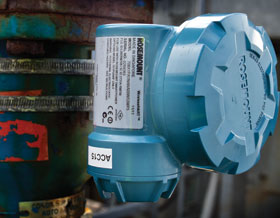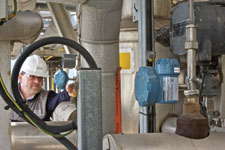

Since the credit crunch began in 2008, when fossil fuels were inexpensive, the cost of energy, electricity, gas and the production of steam have steadily increased. For some companies, energy costs now amount to over 25% of their total operating costs. At the same time, within industry there has been a greater emphasis on improving the environmental impact of production.
For power stations, refineries, chemical, petrochemical and other heavy industries, the average plant was built at a time when the cost of fossil fuels was low. This meant that the need to design a highly energy efficient plant was far less important than it is today. In addition, plant emissions were also far less of a concern than they are now.
Industrial automation companies such as Emerson Process Management are helping industries achieve the improvements they need, such as reduce carbon emissions, increase plant efficiency and reduce energy consumption, to ensure they meet the expectations of the market and stay profitable. Some of the key areas to focus on are steam traps, compressed air stations and pressure relief valves (PRVs).
Steam traps
When steam leaves the boiler it has almost 100% quality (fraction of a saturated mixture that is steam). As it is distributed throughout the plant, heat is lost and some of the steam condenses and is collected in low points within the distribution network. Condensate forming within steam pipes can produce water hammer effects, which can cause costly damage and present safety issues. To prevent this problem steam traps are installed to remove condensation and enable the steam to flow freely.
Steam traps play an important role in helping to:
* Improve safety for plant personnel and equipment.
* Increase plant throughput and product quality.
* Reduce maintenance costs.
* Reduce energy consumption, lowering fuel costs.
* Meet environmental standards and goals.
Steam traps failing in the closed position allow condensate to collect within the steam line. This build up can prevent steam from passing, with eventually slugs of condensate producing the ‘water hammer’ effect. This can cause damage to the pipework and fittings.
However, this is not the case for steam traps which have failed in an open position. Apart from unusual heating patterns or noticeable sound, there are generally no external signs to indicate a defective steam trap which has failed in the open position.
Steam traps failed in an open position do not pose a direct threat to the process or safety of plant personnel, but there is a significant financial impact on the bottom line of the facility. When steam traps fail in the open position they allow steam to pass through continuously. Each steam trap has an internal orifice that limits the amount of steam/condensate that it will pass, but devices installed on large, high-pressure steam lines can pass more than 270 kg/hr of steam. Depending on the cost of generating steam at a facility, this can cost the plant upwards of $33 000 per year in wasted energy.

Steam trap failure rates
When talking about failure rates it is useful to consider the underlying failure rate. Ageing plants may appear to have a higher failure rate from years of not identifying and/or replacing failed traps. Process plant operators report that in annual audits they experience upwards of 35% failure rates.
This is usually an indication that failed traps are accumulating and not that the underlying failure rate is actually that high. An initial plant-wide survey found that of 887 traps tested, 12,4% were defective and more than $415 000 worth of steam was being lost annually as a result of the failed traps.
It is more likely that the underlying failure rate of steam traps is closer to a generally accepted 15% – 20% per year.
Manual steam trap audits – creating a false sense of security
Many operators only perform steam audits once a year. Failed steam traps can therefore go unnoticed for long periods, which can leave the plant exposed to the safety, process and financial impact of failed steam traps. By increasing the insight into the health of steam traps, maintenance can be better managed, helping to reduce the impact of failures and improve the efficiency of the plant.
The best manual steam trap audits use testing devices that monitor flow (usually through acoustic noise) and temperature. Technicians must walk through the plant performing analysis on individual steam traps one at a time. For the test to be reliable, trap type, size and operating pressure must be entered into the monitoring equipment to enable actual readings to be compared with the ideal parameters. Some testing devices used are able to make this comparison in as little as 15 seconds. However, a 15-second test interval only allows a maximum of two cycles to be completed of a steam trap operating normally. In many cases, the noise caused by the flow will vary enough, even in a blow-through steam trap, to trick the testing equipment into believing that the trap is operating correctly, even if it has failed.
Another problem is that steam traps are only in service if the sections of the steam distribution system where they are installed are being utilised at that time. During an annual audit, only those traps which are in service can be checked. This can mean that as many as 30% of traps are not analysed during an audit. The next audit may be 12 months away and even then, the particular trap might be offline again.
Distribution of steam trap sizes
In order to implement a continuous monitoring programme it is important to know where the largest impact is on the process. The factors that decide where the impact is include both the size and failure rates of steam traps, their location in the plant and the important plant equipment they are protecting.
Knowing the status and condition of every steam trap could enable a 20% reduction in steam loss that would contribute to over $5 million a year saving in lost energy. Automated monitoring systems are available to enable operators to continuously monitor steam traps, helping to reduce the impact of failures.
The majority of failed steam traps have a relatively low financial impact of less than $7000 a year. Those that create greater losses, should they fail, are referred to as ‘high value’ steam traps. The average annual failure rate of high value steam traps is 10-15%. Financial impact is just one consideration when identifying high value traps. Energy loss is actually one of the least important impacts of a steam trap failure. Operators must consider high value steam traps to be those that:
* Protect important plant equipment.
* Would have a large impact on plant processes if they failed.
* Are located on larger, higher pressure steam lines.
* Have a known high failure rate.
Automated steam trap monitoring
Once-a-year inspections of steam traps leave plants vulnerable to significant energy loss 364 days a year, resulting in weeks or even months of steam escaping your process. Manual measurements from handheld devices designed to measure either temperature or ultrasonic noise alone are imprecise and expensive. Using Emerson’s Rosemount 708 Wireless Acoustic Transmitter, it is possible to monitor critical steam traps every minute of every day, to address failures as they happen and maximise energy savings. A combination of temperature measurement, with acoustic ‘listening’ provides visibility into steam trap states. Through a dedicated steam trap monitoring software programme, users are able to see the status of every trap, including if the trap state is normal, cold (stuck closed) or blown-through (stuck open). This software does not require integration with the control system, making it fast and easy to install and viewable outside the control room – from the office or any location.
Renting equipment to inspect steam traps is expensive and can take employees away from other responsibilities. Hiring external companies to handle the monitoring adds complexity and raises safety concerns. With the Rosemount 708 Wireless Acoustic Transmitter, expensive fees can be saved and time-consuming manual inspections eliminated. Unlike rented equipment or outside services, the Rosemount 708 is an investment that can be leveraged as the plant adopts more wireless technology.
Smart Wireless system
It is possible to gain visibility to all critical steam traps, no matter where they are located. Emerson’s Smart Wireless approach allows steam traps to be monitored throughout the plant, even in remote and hard-to-reach locations, with greater than 99% data reliability. The Rosemount 708 works with the plant’s existing WirelessHART network. If the plant does not have a wireless network, it is easy to start small with a Smart Wireless Gateway and any number of transmitters; with the resulting energy savings, the system will pay for itself within a matter of months.
For more information contact Danielle Aychouh, Emerson Process Management, +97 155 727 5910, [email protected], www.emersonprocess.com
| Tel: | +27 11 451 3700 |
| Fax: | +27 451 3800 |
| Email: | [email protected] |
| www: | www.emerson.com |
| Articles: | More information and articles about Emerson Automation Solutions |

© Technews Publishing (Pty) Ltd | All Rights Reserved